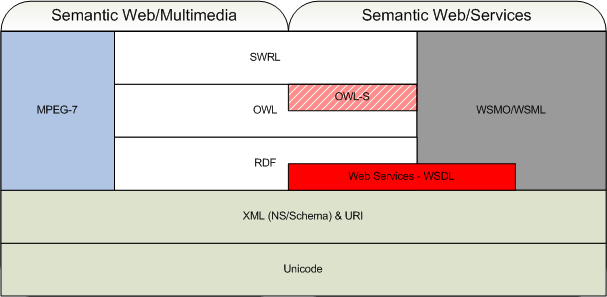
Fig. 1.: The Semantic Web Stack with Multimedia Metadata and Web Service descriptions.
JOANNEUM RESEARCH (Institute of Information Systems & Information Management)
Michael Hausenblas, Harald Mayer, Georg Thallinger
In this document we outline our position concerning Semantic Web (Services) with special attention to multimedia resources. First we introduce ourselves, and then we describe our point of view w.r.t. the Semantic Web stack and highlight important issues in our working domain, i.e. in the realm of digital media information systems.
JOANNEUM RESEARCH (JR) is one of the largest non-university research institutions in Austria. Our research is geared to the demands of business. Our range of services includes applied research and technological development; technology-oriented consulting and sophisticated technical services; consulting, support and project management in applications for national and international funding (e.g. EU framework programmes) with a special focus on small and medium-sized enterprises.
The Institute of Information Systems & Information Management (IIS) at JR has a track record of over 15 years of applied research in the field of information systems and digital media ranging from products to EU funded projects (as participant as well as a co-ordinator). With a staff of 40, the institute develops new methods designed to organise the constantly growing flood of data and to selectively filter out desired information. At the institute we are focusing on two areas:
The great strength of the institute is the tight intermeshing of these two areas of research - as for today the digital world no longer consists of numbers and text alone, but also increasingly offers images, audio and video.
IIS research and product scope comprises the following technologies:
Current activities1 include (non-depletive list):
Projects in preparation cover the following topics:
In the area of multimedia indexing research currently focuses on the extraction of high level semantic annotation based on low level features (e.g. colour layout, spectral information ...).
In the following we concentrate on three issues relevant to this workshop from our point of view. These are Semantic Web, Multimedia Resources and Semantic Web Services. We welcome and support the evolution in the domain of knowledge representation on the Web, though we doubt that the current and proposed standards will completely solve the genuine problem in the context of semantic multimedia handling (cf. the semantic gap, e.g. Grosky et.al. in "Emergent Semantics and the Multimedia Semantic Web").
From our point of view the Semantic Web stack currently is used as follows: (cf. Fig. 1):

Fig. 1.: The Semantic Web Stack with Multimedia Metadata and Web Service descriptions.
Where (from bottom up):
As IIS already utilises Semantic Web base technologies (RDF/OWL) in several projects, our idea is to provide the community with scaleable, portable and flexible tools, libraries and frameworks. We are confident, that with increasing standardisation efforts (SPARQL, WSML/WSMO, etc.) the dissemination of Semantic Web base technologies, i.e. infrastructure as languages (representation, query, and the like) and protocols is on a promising way.
The main concern we have on this issue is the potential one-sidedness of Semantic Web standards w.r.t. textual data, i.e. not directly supporting multimedia-related metadata in the first place. Although multimedia seems to be an issue (cf. W3C TR "OWL Use Cases and Requirements - 2.2 Multimedia collections) description of audio-visual content is not explicitly addressed by and large.
We see one major issue concerning the description and the respective retrieval of multimedia-centred metadata in the context of the Semantic Web. Having ISO MPEG-7 on the one hand as a detailed feature description schema for multimedia resource and OWL-based languages on the other hand for the high-level semantics, we by and large agree with the analysis given by van Ossenbruggen et al in "That Obscure Object of Desire: Multimedia Metadata on the Web (part 1 and part 2)" w.r.t. the interoperability issues and their consequences.
We hope to see high priority given to the issue of interoperability and integration of W3C and ISO standards thus focusing on further research and emergent standards in this area. Our approach in bridging the semantic gap2 is to keep relevant low-level features in MPEG-7 and representing high-level features in OWL-DL. For a certain domain (movie production), semantics can be defined and therefore high-level features derived from low-level features as indicated in Example 1:
OWL.isLandscape ← MPEG7.dominantColour: (BLUE, GREEN) , !MPEG7.audio
Example 1.: Deriving high-level features from low-level features.
Another backbone of the Semantic Web in our opinion is the widespread use of (semantic-aware) Web Services. It should be clearly pointed out how new standards (as e.g. WSML) fit into the Semantic Web stack, that is their layering on top of syntactic-concerned languages as WSDL. Moreover we are interested in how Semantic Web Services are intended to be used in conjunction with existing (de facto) standards as BPEL and the like.
Again we would like to contribute to an in-depth discussion on how scaleable, multimedia-semantics-aware applications can be set up in distributed environments based on Web Services. As most if not all current applications using Web Services nowadays are targeted at (company) Intranets, we strongly believe that there has to be a sound evaluation phase before "real" Internet Web Service applications can be put into usage.
(1) An overview of past and ongoing projects is available at the IIS homepage (projects).
(2) Demonstrated already within the NM2 project.
Michael HausenblasLast modified: 2005-04-27